UC Berkeley Society of Women Engineers on Project Vesta at JIFX: Technologies for Wildfire Mitigation
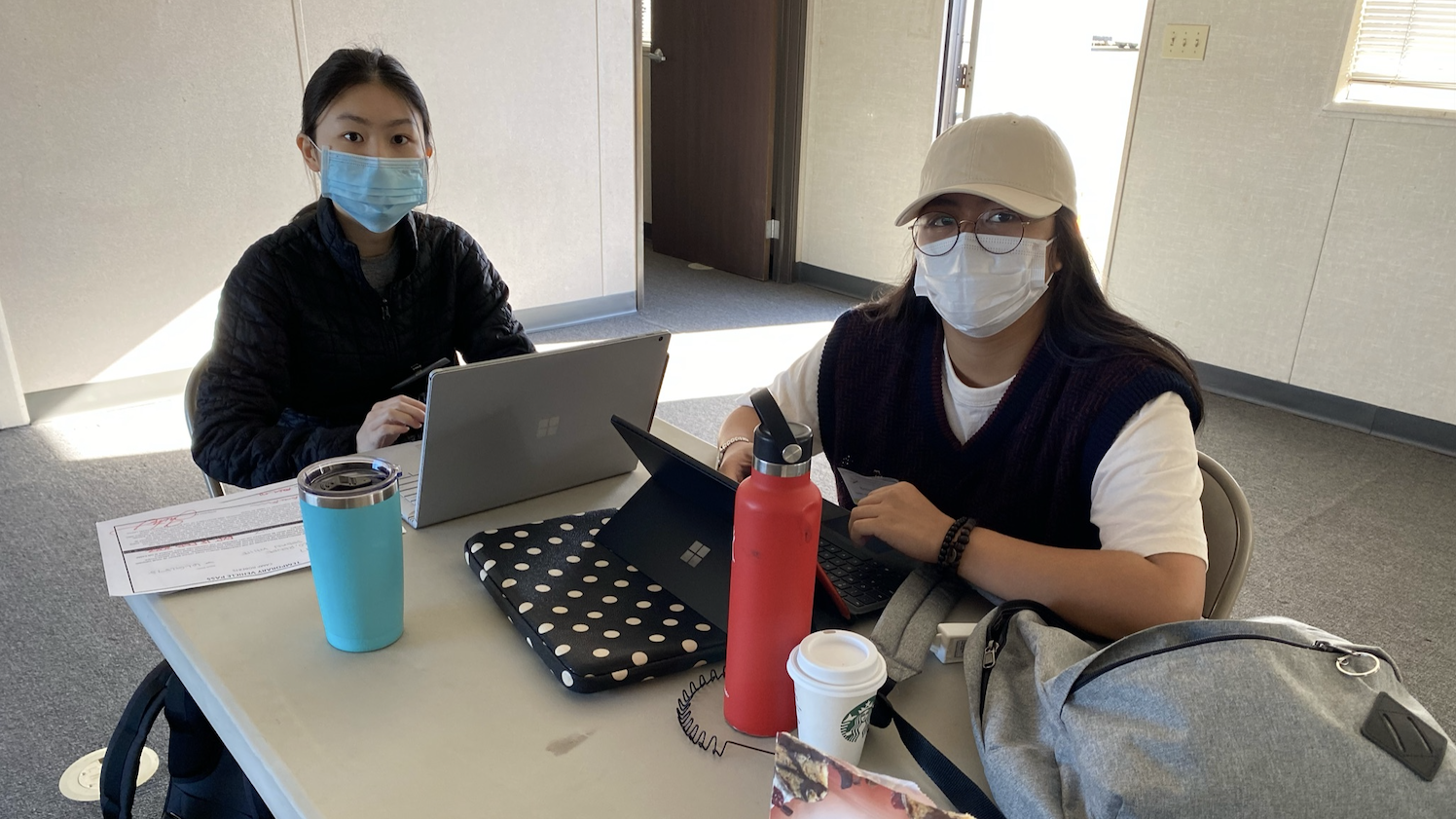
The UC Berkeley Society of Women Engineers (SWE) participated in the Naval Postgraduate School Joint Interagency Field Experimentation (JIFX) demonstration that took place this past February at Camp Roberts. Phoebe Chang and Renee Francisco are both Cal students and currently serve as co-leads for this year’s SWE Team Tech, a collegiate competition team. With Disaster Lab, they had the opportunity to speak with different disaster-technology and management groups present during the event:
- BEAM Global
- Arcimoto
- Eirene.AI
- DD DANNAR
- Parallel Flight Technologies
- Komodo Fire Systems
- HEN Nozzles
- TESIAC
- SoCal Tech Bridge
BEAM Global
Could you explain the technology you are demonstrating?
For Project Vesta at JIFX, we’re demonstrating the ability to charge multiple vehicles and other tools that need sources of energy without any connection to the grid, and completely by renewable energy. So we’re using solar power to generate electricity, store it, and deliver for EV charging to an emergency power panel that has 120V and 240V plugs, and to regular plugs for powering equipment.
What is the use case in the context of fire or disaster?
One of the things that are most important in these remote locations is that they don’t have power. And if we’re trying to electrify and take fuel, like gasoline and diesel, out of the equation for fighting fire (which could actually feed fire) you need power, a source of energy like electricity. So as we electrify, whether it’s in the air with drones or on land, like with the Arcimoto and DANNAR vehicles, they still need power sources.
What is the benefit of being at JIFX?
Working with the Society of Women Engineers. Working with you guys to see the processes that need a person – we’re trying to do this autonomously. How do we remove a person from plugging in [a charger]? It may seem simple and not a hard problem to solve, but it’s one of the areas that we can’t take a person out of the equation right now. Also just under the power needs out in the field, with the equipment that we’re powering here. Parallel Flight Technologies’ drone was a different charging profile than we usually have out in the field. Learning what amperage we needed to deliver and what they needed was a great learning experience. We also needed two EV charging plugs and we only came with one, so we’ll want to change that for the next time. So, we’ve learned a better configuration for this application.
What have you learned thus far?
It’s just so important to bring companies and their technology together. It may seem like, to those in an academic environment, that this is the way things usually work. “How else do problems get solved?” It really is hard for companies to find an environment like this, that has a big problem to solve together, spend months doing it, and there isn’t necessarily a huge commercial outcome. We’re solving a big problem that saves lives, and it’s very mission-driven. It’s not easy to pull that together, so that’s something that, just sharing and learning here, I hope everyone can see. I wouldn’t have known many of these things, like how to charge a drone that’s all-electric; a lot of drones are still gas-powered. The learning of working across technology is not a common thing you’ll find – that’s a gem out of this program.
Have any new use cases emerged for your technology?
I don’t think anything new has emerged out of this at this point. Just the validation of some things we wanted to do, such as wireless charging. We already have a patent for wireless charging, we’ve worked with a wireless charging company and we know we can do it; we’ve done it before. As soon as the vehicles can have receptors for wireless charging (conductive charging), then we’re ready. I wouldn’t say we have anything new, but I can see that would solve big problems out in the field once the hardware gets ready to receive that solution.
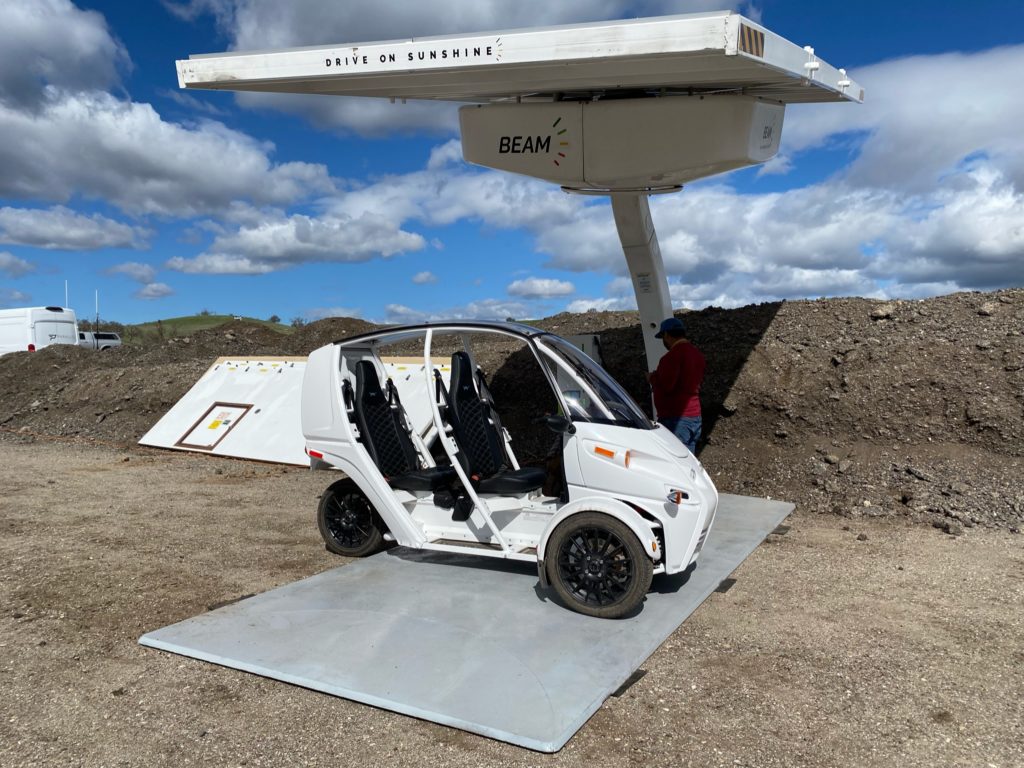
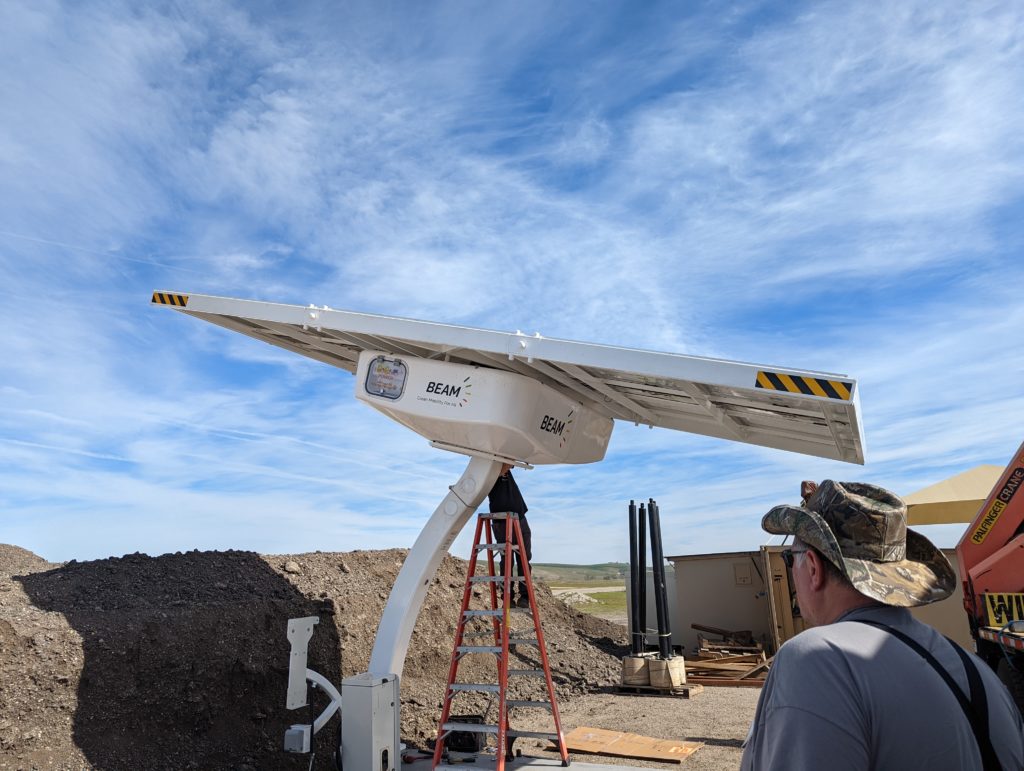
Arcimoto
Could you explain the technology you are demonstrating?
We have an ultra-efficient, 3-wheeled vehicle platform that is electric. It gets about 70 miles per gallon-equivalent, goes 80 miles an hour (you can take it on the freeway), has a range of about 130 miles of city driving and 60 miles of freeway driving. It’s really just a reimagination – a new architecture – of a vehicle platform that does what we use cars for the most like driving to work, going to the store, and other needs for daily driving. So if we actually design the platform for that use case, which is about 75% of all the miles that we drive every day, you can reduce the size of the vehicle, increase the efficiency, and reduce cost.
What is the use case in the context of fire or disaster?
The way I’m looking at it is the vehicle can be sitting on a solar-powered charger in the middle of nowhere, ready to go when there’s an event [of fire] detected. And therefore, you don’t need to spend a ton of money building infrastructure with the technology available now. We can just have this pod sitting out there and get [the vehicle] to the event faster with a lower cost of the platform and the energy used. My understanding is that, in general, getting to the event faster prevents the event from growing and getting larger, so it’s easier to deal with as we use fewer resources. From this event, I also learned that there’s a need to get, possibly, goods in and out of wherever that base is where people are operating out of, and if there’s injury, getting people out is important. It feels like our platform is really good for that, especially if you look at the cost of [standard emergency vehicles and] other available technologies. Those vehicles were hundreds of thousands of dollars, and our platform is going to be way less than that – I see probably 10 times less the cost to do a similar job.
What is the benefit of being at JIFX?
My dad used to say that what’s interesting about the world of business is that a lot of people – businesses – live in a bubble, and one business [sector] might have solved a problem that you’re trying to solve and you just don’t know it. They’re doing something a little different that applies to them, but when you look at it, you think, “Wow, that actually applies to our process in a strange way.” I think it’d be really hard for Arcimoto to create value, by itself, fighting a fire, and showing up here with a bunch of teams [demonstrating] different technologies, we’ve improved the capabilities of our platform using other people’s technologies by a huge factor. There’s no way Arcimoto would have thought to invest money in reinventing the nozzle that distributes fluid to be more efficient, and there’s no way Arcimoto would invest in material sciences to develop a fluid that fights fire ten times better than water. But how does that fluid get delivered to the fire, and how can that nozzle be used in [the case of] a fire? We teamed up together and proved that us working together actually does achieve something that may compete with the Humvee, you know. I’m going to deep dive, but a gentleman yesterday said that the Humvee has 250 gallons of water on it, and that vehicle is around $200,000. And they use it to actually start fires, and the water is on the vehicle in case of an emergency. I think we might be able to demonstrate that with the HEN and the Komodo fluid, this little Arcimoto has the same potential of 250 gallons of water. I’m super stroked, can’t wait to come back!
What have you learned thus far?
I learned that, most importantly, the vision that the team started with is possible, that nothing in my mind proved that we couldn’t do what we dreamed of in the first meeting. That’s why I was here. I actually wanted to prove that we couldn’t do it because that’s good, right? It’s good to know if you’re like, “This will never work. It was a good idea, but we should probably stop now.”
Have any new use cases emerged for your technology?
Using the vehicle for moving people who were injured – people who do emergency response brought that up as a use case that would be really valuable. I learned about a company that may be able to solve how we communicate to the vehicles when we’re autonomous, doing that through a more reliable, secure network, which is a big deal. That is the end goal for Arcimoto – to be the low-cost, autonomous platform for moving people and goods around, so that was a significant find. Just meeting folks who have market potential, actual connections to getting all of these ideas to the market who I didn’t know about before coming to the event.

Eirene.AI
Could you explain the technology you are demonstrating?
A camera agnostic, artificial intelligence computer vision system that can essentially take in video streams from any kind of camera and analyze it for fire or smoke, and then alert the identified parties of potential danger. So that way, early detection can take place and a response can happen faster and sooner.
What is the use case in the context of fire or disaster?
Kind of what I just explained in my previous statement – potentially, if there are hillside cameras, there are security cameras already in place, and they are already connected to the internet, then they can stream into our cloud system that will go ahead and analyze them actively. This reduces the strain on someone that might have to be looking at hundreds of screens to be looking for fires, and make it so they only have to look at 2 or 3 that would be relevant.
What is the benefit of being at JIFX?
I would say the biggest benefit of being at JIFX for us is having a live fire scenario that was controlled and was essentially planned in the way that we were able to test the constraints of our technology. One of these is being able to have things that might look like fire, right next to an actual fire, and to be able to build out these occlusion data sets, and then just being able to record data and feed that back into our model to continue improving. I would say the other most valuable thing was to be able to meet other individuals and build partnerships for the long run.
What have you learned thus far?
We learned a few things. We learned that if we are recommending a camera system to a potential customer, we need to understand the specific place they’re coming from in order to do that. We also learned that the cloud component of our technology isn’t necessarily for all solutions; not everything is one size fits all. So for a long time, we were kind of avoiding the edge solution because we wanted to focus so much on the camera agnostic piece of our technology. But I think JIFX has a place for that, and luckily it’s very easy to implement. Then having different models for different situations, and making sure we’re implementing that based on a specific area that our technology is being implemented in.
Have any new use cases emerged for your technology?
Yes, absolutely. So for example, in remote areas that might have cameras but are not necessarily connected up, being able to use the Tomahawk or the NVIDIA Jetson in order to do that processing on the edge and provide that localized network. Even if that area doesn’t have access to the broader internet, nor have satellite internet (it’s something that might not be fast enough to connect to the cloud system), they can still have extremely fast processing, by us just giving them something that’s smaller than a textbook. And just by plugging it into their system, you can make sure that it’s constantly monitoring and still providing all the local authorities access to any alerts or any detections as well (or regular fire or smoke).
DD DANNAR
Could you explain the technology you are demonstrating?
DD DANNAR, we’re a manufacturer, an OEM, for an industrial electric work vehicle. So we make a multi-function, multi-purpose industrial-sized vehicle that can consume power and deliver power, as well as we utilized, in cross-functional ways, similar to a Bobcat or a Skid-Steer vehicle. We have a lot of different options and configurations as an all-electric vehicle company.
What is the use case in the context of fire or disaster?
So with the DANNAR, we have a couple of different avenues or parallels that we’re working on with the Project Vesta team. One is that it’s basically a mule to provide fire suppression chemicals and solutions like water to autonomously deliver those to a point or a named focus area. The second opportunity is to provide power to areas that might not have easy access to electricity, so things such as your cell towers, as well as other technologies that are investigating and analyzing winds and air quality, where there can be opportunities for fire. We can carry up to 500 kWh, and we can distribute that through a simple, standard electric plugin, or you can the availability to charge other electric vehicles to be able to output in higher amps like 240 V. We can also tether multiple units of ours together and then create a mobile microgrid that can power houses, neighborhoods, small buildings, etc.
What is the benefit of being at JIFX?
I think for us the benefit was the opportunity to discuss with the other vendors how our platform could be accessible to them and where we might fit in the overarching scheme because there are a lot of partners there that have a specific role, and ours is pretty open. We can support a lot of the different partners that are out there with the technology we are bringing. But absolutely, participating in that holistic group approach [was a great opportunity]. We had the value of talking to maybe 6 partners instead of just one.
What have you learned thus far?
I think #1, having the value proposition and industry knowledge from the firefighters directly, where they saw an opportunity for us was key. We’ll be able to take that information and put it into the second phase of this, whether or not that’s in the May event or further down in the summer. What I’m excited about is that we didn’t come to the event prepared specifically for this project just because of the timing involved; we couldn’t configure that quickly. But, I think what we learned is that I’ve got a very good narrow focus now on how to make the unit usable without a lot of extra cost from us in that next level that can jump us ahead two or three steps from where we’re at today. So seeing it live, being able to let people touch it, feel it, and simulate the tests that we did – that was all really helpful to us.
Have any new use cases emerged for your technology?
I think a couple of things, we know we’re not a power source but knowing that someone has developed a 5G mobile cell tower, we can easily implement that on our machine. Our vehicle is driven by remote control, but even before we get to that step, I was introduced to some technology to drive the vehicle from afar. We can do a 1-mile line of sight, but if I put a couple of cameras in front of the vehicle, I can do it from almost a mobile command station where I’m only half a mile behind it. But I can see where I’m going, so I was excited to see what the Parallel team can introduce us to, and some different things there. We’re also hoping to get the vehicle ready to support the next step of JIFX, depending on where we plan to do the next tests.
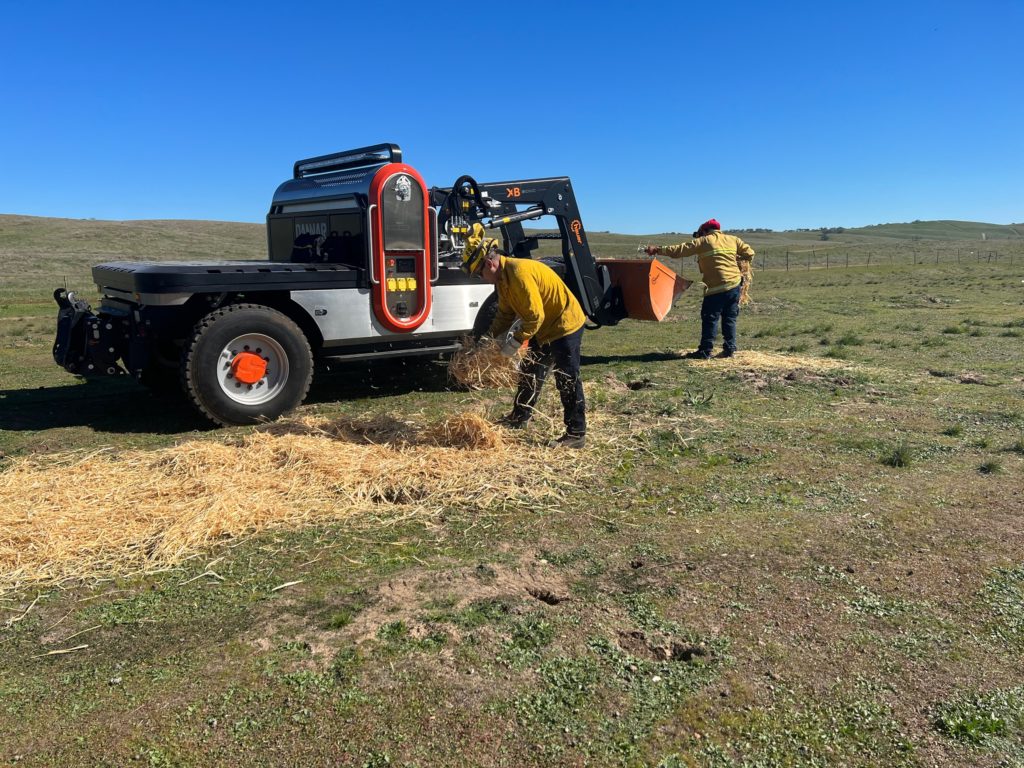
Parallel Flight Technologies
Could you explain the technology you are demonstrating?
We have a drone platform, and we’re demonstrating Serenity at this event, which is our all-electric research development platform. Our core technology is our Parallel Hybrid System, which is unique as it puts a hybrid power pack on all four sections of the quadcopter.
What is the use case in the context of fire or disaster?
Our company was founded by a group of people that were directly impacted by the CZU Complex fire and a handful of other fires that had happened in the Santa Cruz mountains, to the point where they were all evacuated. Most of our team has also been impacted by fires in the Santa Cruz mountains area. Our product was designed with the intent to resupply firefighters and find a way for us to initialize attacks on fires or help create fire breaks.
What is the benefit of being at JIFX?
We’ve gained from integrating with Komodo specifically but also have benefited from being a part of a larger organization that is trying to autonomously detect and stop large-scale things from happening.
What have you learned thus far?
Specifically, due to our introductions with Project Vesta, we met Komodo and realized that there is a way that we can, from the air, actually start attacking wildfires or prevent fires from getting out of hand.
Have any new use cases emerged for your technology?
No, I don’t think so.
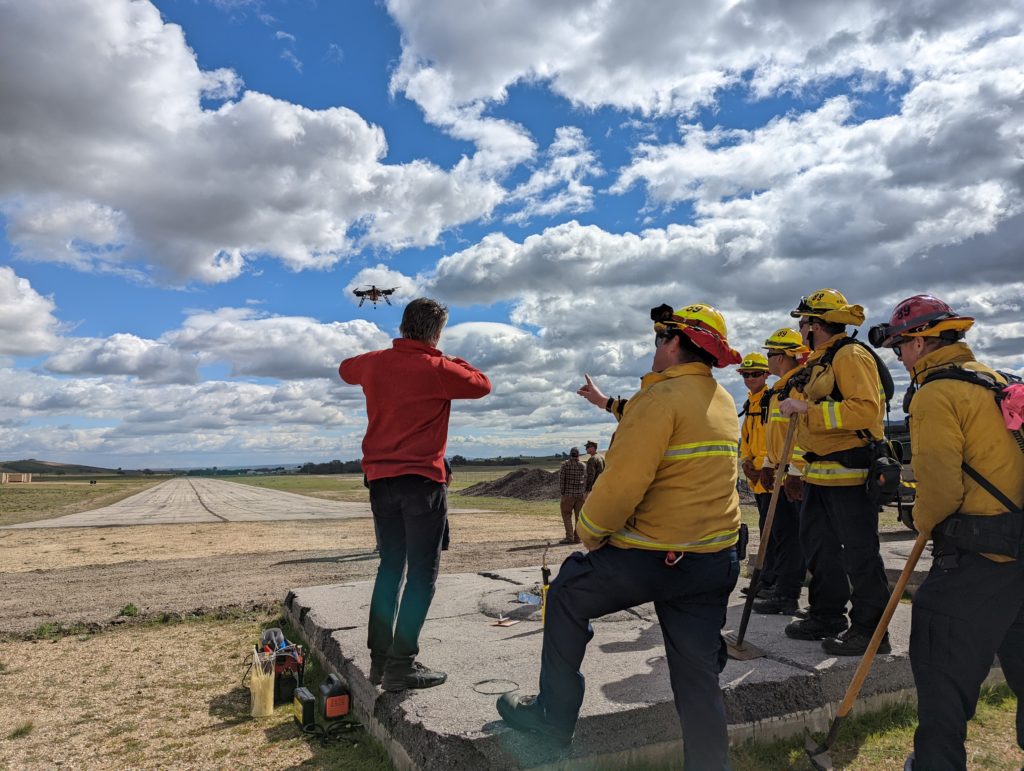
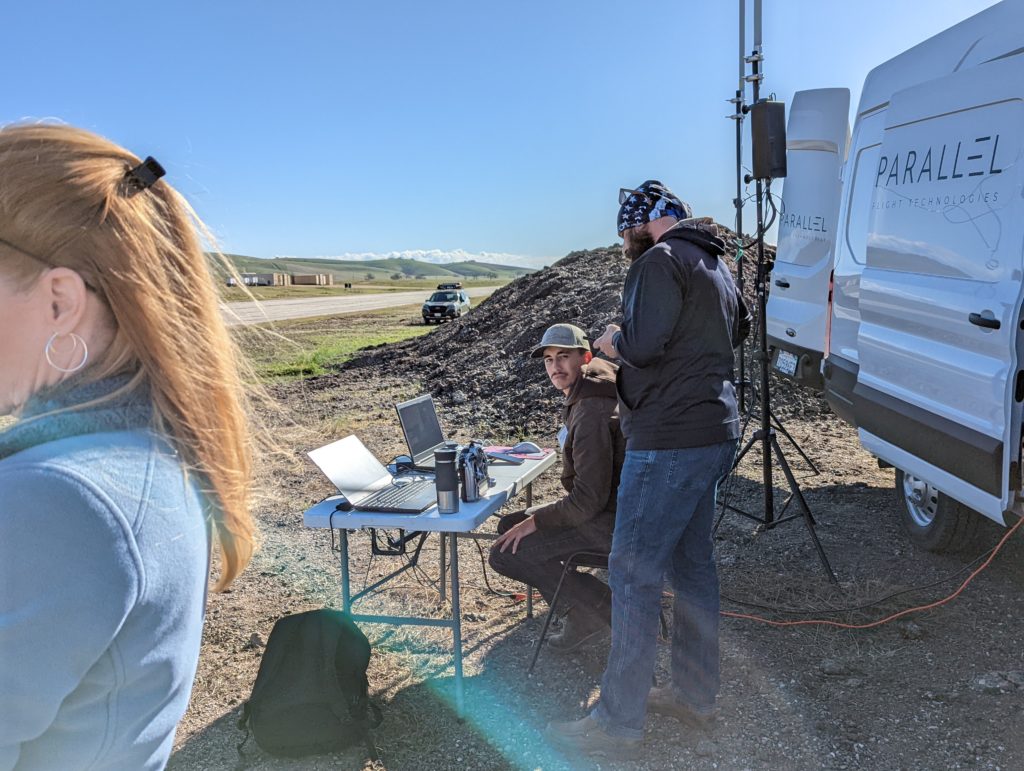
Komodo Fire Systems
Could you explain the technology you are demonstrating?
So Komodo, for the last 5-6 years, has been developing the next generation of spectrum fire prevention and fire retardant-type products. We were showcasing one of Komodo’s technologies, how it could be effective in wildfire prevention and in fighting large-scale fires.
What is the use case in the context of fire or disaster?
Komodo is an interesting technology in that it does things in one form factor. Typically, you have suppressions like water, fire extinguishers, and so forth. Or you have the traditional wildfire fire retardants that are supposed to slow down the spread and allow the ground crews to be able to get in front of [the fire] and contain it. Komodo does three things. We can go in, in advance, during the dry season and the peak fire season, and wherever there may be a potential for a combustion source such as a campground, a freeway offramp, or a high voltage line carrying the electricity, Komodo can pretty much neutralize [the site] ahead of any potential disasters. As a preventive agent or a prophylactic, we could put this product down and prevent fires. The second way that it works is that we apply the product to an active fire. We’ve done tests where the product is demonstrated, and it is several orders of magnitude better than just water, water mist, or water-full technologies. We were able to demonstrate that at the JIFX event; they applied it to the burning pallets, and I think the comments that the firefighters were making is that they couldn’t believe how quickly it snuffed out the fire. It also helps in not allowing the fire to flare up again, because, with water, you might quench it off and put it out, but if there’s fuel there or if there’s still smoldering of embers underneath, there are many cases where the fire restarts up. There are firefighters that go out and do what’s called mop up. And one comment that the firefighters were making at Camp Roberts was that Komodo not only put it out very quickly but also eliminated the need to go in and do mop up. And that’s huge because that’s a whole other workforce, that’s a whole other tank system [involving] more water. That’s whole other ground crews that are putting the smoke out and putting the embers out, and so forth. So we can go in there as a prophylactic and prevent fires in the first place; in other words, if a spark comes or some source of ignition comes, it’s not going to readily ignite. We can go in there and do a better job than water or existing technologies for snuffing out the fire just by very quickly using minimal amounts. We also eliminate the need for going back and doing the mop up or clean up when the fire is out because water may or may not do the job. And lastly, Komodo is in the traditional sense [useful] because it is a retardant. In other words, you can apply it from the air, you can apply it using ground equipment. If you have a wildfire that is under high wind conditions and is advancing very quickly, you can slow it down and prevent it from going out of control. By putting a fire break wall down, you can direct the area you want the fire to travel. So you can contain it and fence it in, or if there’s a lake you can direct it into that lake so the fire isn’t freely going out of its way to burn everything in its path. Those were some of the ways we were able to showcase Komodo a little bit. Obviously, it was a short 2 or 3 days, but we were still able to see how Komodo had improvements over existing technologies.
What is the benefit of being at JIFX?
The benefit is, #1, you’ve got the U.S. government by way of the Department of Defense [to spectate] – that’s not an audience you can easily get. Having officials and people from the federal government and local state government at a sanctioned event was a benefit. Just having the right type of eyeballs, the right audience, and the right stakeholders there. Secondly, we’re talking about California so we care about [cases of] fire – those are serious issues. Being able to do life-sized burns outdoors is too difficult; you have to go out and get permits, like farmers and ranchers that do seasonal burns who have to go out of their area to qualify for permits and wait to get the approval based on wind conditions and the weather. So to have the ability to have a large area for conducting life-sized burns was a big benefit. Another benefit I thought of was having a consortium, having a group of technology companies, some people being the detection, some people doing delivery like the Arcimoto or the DANNAR, and one, Parallel Flight Technologies, providing the drone. Having been part of a group of entities, I think this was a neat system. We were able to bring all these companies together, focused on the same problem. No one company is going to be able to do everything that needs to be done. These are different disciplines, different technologies, and different skill sets. I think a key benefit was this team approach and having companies with those disciplines and capabilities, basically trying to solve the same problem. Normally you wouldn’t get that; it would take forever to set up the non-disclosure agreements and all the other agreements.
What have you learned thus far?
Not yet, we’re still trying to get all the data and tackle different things right now. We’re looking forward to the next [testing event in May] because there will be fewer unknowns and the parties will have had a chance to do a dry run and familiarize themselves with other technologies. Hopefully, it will be faster [and we can] take more meaningful data. We’re looking forward to it.
Have any new use cases emerged for your technology?
Not yet. We have to review what came out of that week, both internally and with the other team members. And that will feed into the next experimental designs. So I’m sure we’re going to learn more [in the future]. Some of the things that I can say is that we were able to fully bet and test the equipment; we don’t want to have any surprises, like in a couple of cases where the spray systems weren’t spraying at the pressure that we wanted. We learned some logistical and physical issues. As far as the chemistry, no not really.

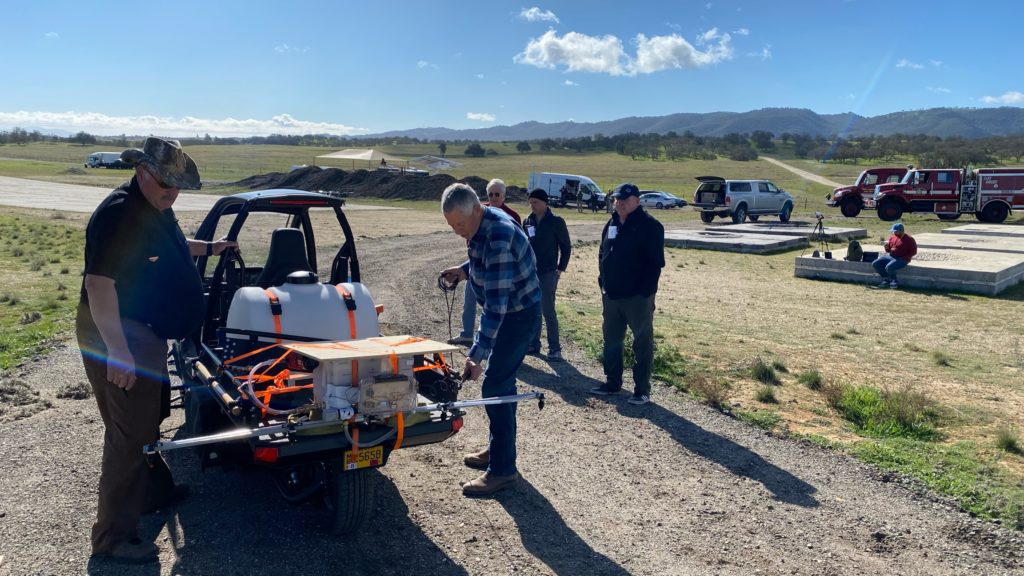
HEN Nozzles
Could you explain the technology you are demonstrating?
HEN Nozzles is developing nozzles that can deliver water in a way that suppresses fires faster. We use computational fluid dynamics to model nozzle materials, and we use that data to see and predict how the water that’s coming out of the nozzle can be. Then we combine this with thermal sciences to estimate what the ideal geometry is for fire suppression. By combining these two, we develop nozzles that suppress fire faster while using less water.
What is the use case in the context of fire or disaster?
So, there are two different use cases. One is for structure fire fighting, which is more municipal houses, residential buildings, office buildings, those kinds of things. [The nozzles] allow firefighters to prevent fire damage from spreading, reduce the probability of flashpoints or flashovers, and actively increase the safety of both the firefighters and the building. For wildland fires, faster suppression is very important to prevent fire from spreading. So HEN nozzles, based on data that we collected, suppresses fire significantly faster, and this allows firefighters to prevent any growth. Since it suppresses fire faster, it can suppress it with less water, which is very important for remote locations where there are no hydrants and people need to carry their own water.
What is the benefit of being at JIFX?
I think for us, we’re a startup trying to collaborate with and understand where our technology can fit beyond traditional fire departments, and it was good to see some of the other products. For example, we used HEN Nozzles with Komodo, which is a fire suppressant from another company that was there. We used the smaller nozzles with Arcimoto for some of the suppression tests that we did there. So that was really beneficial for us to understand. We were also able to do some tests with Camp Roberts Fire Department, which is a wildland fire department that does have use for the nozzles.
What have you learned thus far?
The data from using HEN nozzles with Komodo was something new because we had just used water most of the time. In this event, we used a higher viscosity system, and for Komodo, they have used other nozzles that get clogged. But with HEN nozzles, the geometries were more open to allowing fluids with higher viscosity or those which could have particles in them to overall reduce clogging. So that was something we had never tested before.
Have any new use cases emerged for your technology?
It depends on how we move forward with Project Vesta if Arcimoto continues utilizing HEN nozzles. They did comparative tests with HEN nozzles versus other nozzles, and HEN nozzles were superior in all aspects, so I think that would be a new use case scenario. Komodo was very interested in getting some HEN nozzles for their particular application, something that can spread the product more easily without clogging, so that’s another use case scenario. In the end, I think putting them all together for autonomous detection and suppression systems is something we are all looking forward to.
TESIAC
What role did you play in the management of Project Vesta?
We are acting as a program manager to help facilitate and bring together the commercial, off-the-shelf entities to help perform the mission of Vesta. We also are having interests in developing the commercial markets for the project’s underlying solutions.
What is the benefit of being at JIFX?
Having face-to-face time with technology solutions, building relationships, and understanding greater details on the technology systems.
What have you learned thus far?
We learned a tremendous amount! It’s potentially hard to articulate now, but just the performance of the different technologies. I think what’s important is the interests or needs of these commercial entities, but really the potential of the overarching mission and solution Vesta could bring.
Is there anything that you’re looking forward to for Project Vesta?
I think what I’m more excited about is helping build that common operational picture, through the integration of the technologies – fulfilling that mission more so. And again, bringing together these passionate individuals and their entities together.
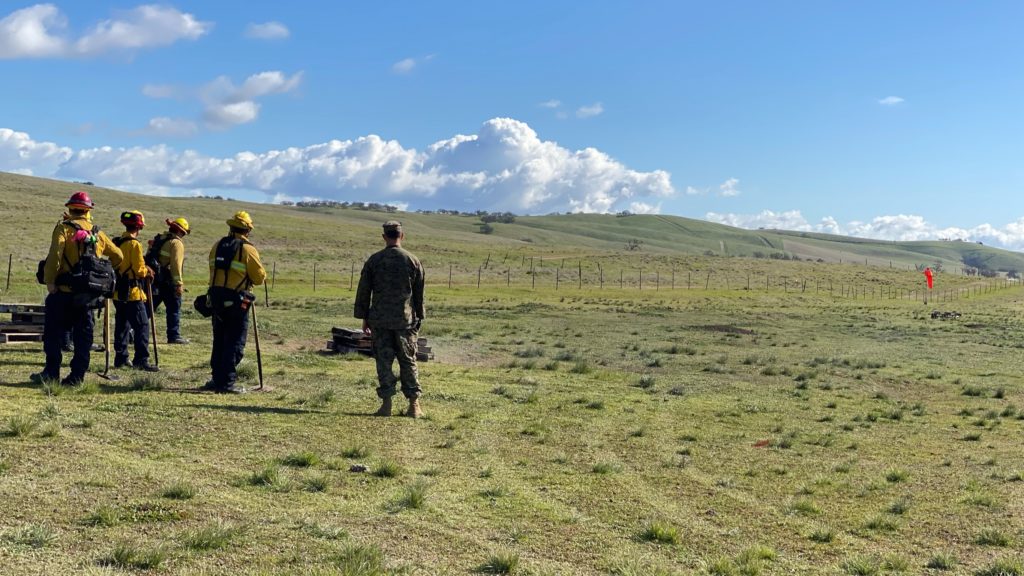
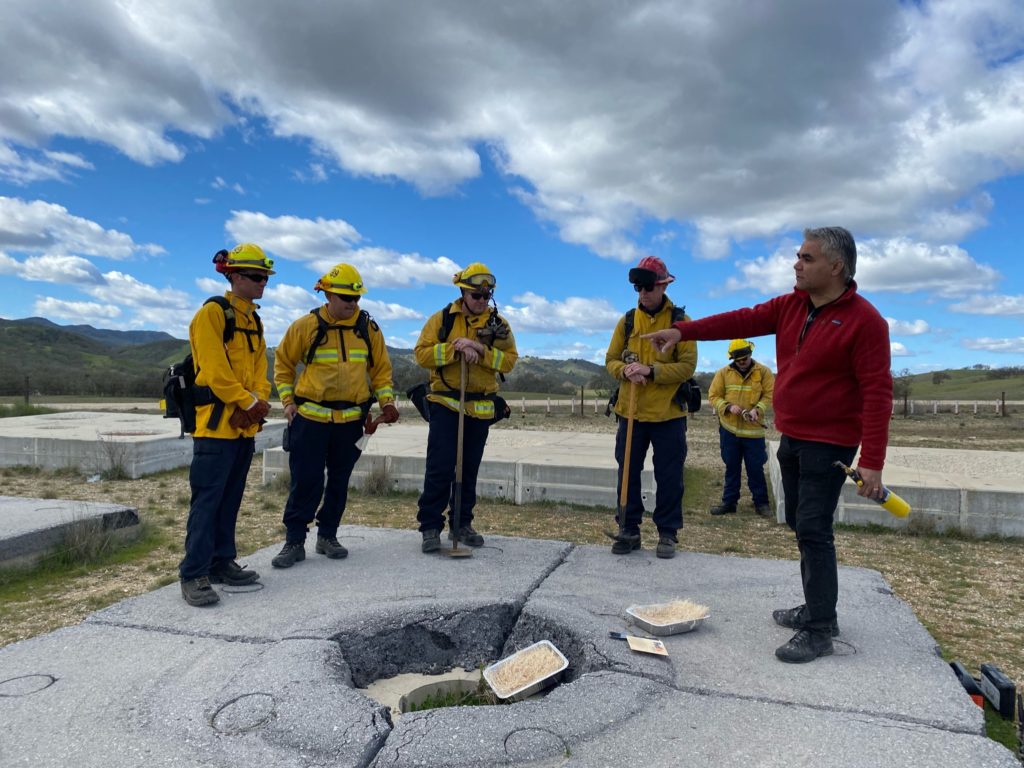
SoCal Tech Bridge
What role did you play in the management of Project Vesta?
I am the principal artificial intelligence analyst for CANA. CANA is a multifaceted company that started out as a consulting firm that focused on data analytics. A specialty of that data analyst aspect was the fact that they were all DoD logisticians, so they gravitated towards those kinds of data problems. From there, they branched out into software development to provide tools and data visualization for that analysis, and the consulting and logistician piece. Since then, they’ve now added artificial intelligence as a capability area, and that’s where I came in. They are currently under contract with the SoCal Tech Bridge to provide stakeholder engagement support and analysis at the end of each individual pilot that they run. So it’s kind of a roundabout way of saying that we’re supporting Project Vesta. Primarily, my role is in enabling that test plan development, collecting the data from the test plan, and from there providing the analytical support to show potential market capitalization, potential DoD transition plan, and really identifying the need for modeling and simulation analysis or potential investment by the DoD for a future pilot that’s kind of a spin-off of this.
What is the benefit of being at JIFX?
JIFX was a nontraditional pilot per the way SoCal Tech Bridge does business, but they were very interested in the disaster theme. Currently, the Tech Bridge has been working with initially a pilot where they took a modified pickup truck and put a mobile capability to connect 5G. And that was step 1 in combating a disaster: how we can restore the communications. Then they started looking at specific disasters like fire where they were looking for some capabilities, and that’s where they came across the NPS project with Captain Cohen. So they decided to do something that they normally don’t do and involve themselves in an NPS project through JIFX. And with that, they’re looking at adding other disaster response capabilities together, in kind of one cohesive package. So if I have communications, and then I have the other elements of fire suppression that we had out here from prediction, detection, to movement modeling, sensors, integrated mesh network could eventually come back through that 5G capability, and then the ability to do things like rapidly respond with electric vehicles, provide electric power, or provide construction support, you can start to see how that use case goes forward. In the future, they’re looking at adding even more capability, as well as delving into how we can do this in other countries if we as the United States want to respond to this humanitarian disaster.
What have you learned thus far?
Some of it was just personal lessons learned as I’ve come from a very structured test environment so this was early-on, literally strapping together these prototypes that had plywood, duct tape, and cargo strap, and it was a lot of “Wow, it would be really good if we could extend this boom out,” and without all of the facilities and structure to do that – just doing these things on the fly to capture those metrics. In my opinion, an event this early on, there’s a lot of qualitative analysis going on, like “That looks better but let’s come back without all the plywood and duct tape to actually have a device that replicates that, and get that quantitative analysis that’s going to inform future decisions.” So just seeing that aspect, never having had been involved this early on and literally strapping things together – but I’m really excited to see how this goes forward.
Is there anything that you’re looking forward to for Project Vesta?
There was what I kind of previously described with fire and potential hurricane response – thinking back to Hurricane Katrina or Hurricane Florence around the east coast. With Hurricane Florence, which I was personally involved in the response to, we were without power for our installation for 3 weeks. We were without cellphone coverage for 2 weeks. We had no landlines for almost a month, and we were down to attachable radios. We were literally running out of food because we had no method to cook the food. So you start looking at how you can branch out specific capabilities to figure out how to restore the power, find the people, help the people, feed the people. And you can apply that same set of capabilities to earthquakes, hurricanes, volcanos even. We are looking at some of these things for robotic capabilities in higher risk and remote situations. Right here [at JIFX] is essentially a grassland wildfire scenario, but if you think through how a typically remotely detected wildland fire is, you see the fire, you predict where the fire going, but then they send in human smokejumpers as their initial response. So to do that to an area that has no actual infrastructure to get there, these smokejumpers jump in to do this very, very dangerous job. And what they’re usually looking for is that predictive analysis we could provide on where to place themselves, then through their own thought process determines where is the closest natural fire break. They’re jumping in with nothing but hand tools, and what they’re going to do is try to augment that natural fire break to remove the fuel in front of the fire. Meanwhile, you have what’s called hotshot crews that are manually cutting a line with typical gas breathing equipment to get the assets to the smokejumpers. We want to be able to augment that initial response capability with some more aviation-delivered assets. We want to augment the hotshot crews by cutting that ripe, something like the DANNAR that can provide power, that has the 5G network, provide network communications to them, and then link up the initial troops that go in. Now you’ve got the common operation picture we’re hoping to provide, that can manage all those assets and those huge distances. And you can see how that all comes together.
Interviews compiled by Phoebe Chang and Renee Francisco in collaboration with the Disaster Lab.
